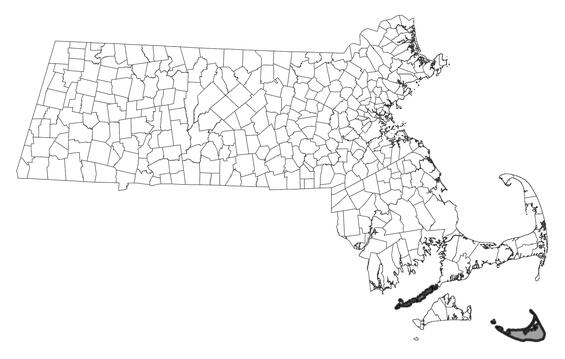- Scientific name: Cicindela limbalis
- Species of Greatest Conservation Need (MA State Wildlife Action Plan)
- Threatened (MA Endangered Species Act)
Description

Claybank tiger beetle (Cicindela limbalis)
Tiger beetles are so named because of their “tiger-like” behavior of chasing down and capturing prey with their long mandibles. The claybank tiger beetle (Cicindela limbalis) is 11-16 mm (0.4-0.6 in) in length (Pearson et al. 2015). It is metallic, reddish or purplish brown in color, with a varying degree of metallic green highlights and distinct white maculations (spots and bands) on the elytra (wing covers). The purple tiger beetle, or “cow path tiger beetle” (Cicindela purpurea) is similar. However, the claybank tiger beetle has middle maculations (the elongate bars in the middle of the elytra) that are complete, extending to the outer edges of the elytra. On the purple tiger beetle, these maculations do not reach the outer edges of the elytra. In addition, the purple tiger beetle very rarely has front maculations at the humeral angle (the “shoulders”), while the claybank tiger beetle almost always does.
Life cycle and behavior

The claybank tiger beetle has a two to three-year life cycle (Knisley & Schultz 1997). Adult beetles emerge in late summer or early fall, overwinter, and are active in spring and early summer, when mating and egg-laying occur. Larvae develop through the first summer and autumn, overwinter, and continue development in the second spring and summer. If sufficient size is attained, pupation occurs underground by late summer, and adults emerge from their pupae in late summer and early fall of the second year. Otherwise, larvae overwinter a second time and complete development during the second spring and summer, pupating by late summer; in that case, the adults emerge in the late summer and early fall of the third year.
Distribution and abundance
The claybank tiger beetle ranges from the Maritime Provinces of Canada, south to New Jersey, and west to the Northwest Territories and Colorado (Pearson et al. 2015). In Massachusetts, this species is restricted to areas of suitable habitat along the coastline of the offshore islands south of Cape Cod.

Distribution in Massachusetts. 1999-2024. Based on records in the Natural Heritage Database.
Habitat
The claybank tiger beetle inhabits sparsely vegetated clay and till banks and cliffs. Larval burrows occur in sloping banks of clay soils (Pearson et al. 2015). In Massachusetts, the claybank tiger beetle inhabits maritime clay cliffs with adjacent beaches on the offshore islands.
Healthy habitats are vital for supporting native wildlife and plants. Explore habitats and learn about conservation and restoration in Massachusetts.

Maritime clay cliff and adjacent beach, habitat for the claybank tiger beetle.
Threats
The claybank tiger beetle is threatened by loss and alteration of its coastal habitat, including stabilization (especially armoring) of banks, bluffs, and cliffs, as well as beach nourishment (addition of sand). These activities disrupt the natural regime of erosion and deposition that creates and maintains the dynamic habitat of this species. Other potential threats include off-road vehicles and insecticide spraying. This species is vulnerable to climate change, as its habitat is threatened by sea level rise.
Conservation
Land protection and habitat management are the primary conservation needs of the claybank tiger beetle in Massachusetts. In particular, maritime cliffs and adjacent beaches should be conserved, restored, and managed to maintain habitat for this species and other species dependent on such habitat.
Survey and monitoring
The distribution of the claybank tiger beetle in Massachusetts is relatively well documented, though undocumented or newly colonized sites may yet be discovered. Known populations should be surveyed to document persistence at least once every 25 years; every 10 years is more desirable when practicable.
Management
Management of maritime cliffs and adjacent beaches benefits a variety of species, including the claybank tiger beetle. If stabilization of maritime cliffs is necessary, methods that avoid or minimize armoring of natural substrate are best. Beach nourishment should be avoided, but if necessary, sand from on-site (immediately offshore) should be used. Habitat condition should be monitored and management adapted as needed.
Research needs
The natural history and conservation needs of the claybank tiger beetle are relatively well understood. The future effects of climate change on this species, in particular sea level rise, will likely be detrimental and should be documented.
References
Knisley, C.B. and T.D. Schultz. 1997. The Biology of Tiger Beetles and a Guide to the Species of the South Atlantic States. Virginia Museum of Natural History Special Publication Number 5. Virginia Museum of Natural History, Martinsville, Virginia. 210 pp.
Pearson, D.L., C.B. Knisley, D.P. Duran, and C.J. Kazilek. 2015. A Field Guide to the Tiger Beetles of the United States and Canada. Oxford University Press, New York, New York. 251 pp.
Contact
| Date published: | April 15, 2025 |
|---|